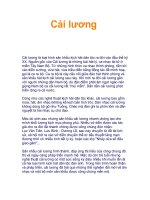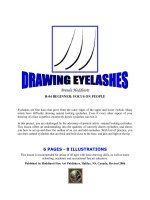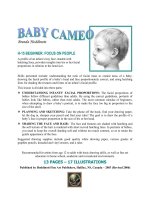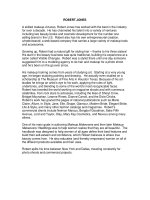Tài liệu Fluppy Puppy doc
Bạn đang xem bản rút gọn của tài liệu. Xem và tải ngay bản đầy đủ của tài liệu tại đây (982.03 KB, 10 trang )
Brenda Hoddinott
I-01 BEGINNER: CARTOONS
& CRITTERS
With a focus on improving your observation skills, this project offers simple illustrated
instructions, to guide aspiring artists through the process of sketching the proportions of a
cartoon of Fluppy the puppy, and then developing and working with a shading map to add simple
shading with hatching lines.
The following two sections guide you step-by-step through this project:
PUTTING PUPPY PROPORTIONS ON PAPER: In this section, your goal is to sketch
Fluppy’s head, ears, and facial features on your drawing paper proportionately correct
OUTLINING AND SHADING FLUPPY: In this section, you outline Fluppy with thin neat
lines. Keep your pencils sharpened so your lines stay crisp and thin. You then plan and
implement a strategy for adding shading to his nose to create the illusion of a three
dimensional form, and add a few extra details.
You need basic drawing supplies including good quality white paper, different grades of graphite
pencils (such as 2H, HB, 2B, 4B, and 6B), kneaded and vinyl erasers, and a pencil sharpener.
This project is recommended for artists from age 10 to adult, as well as home
schooling, academic and recreational fine art educators.
10 PAGES – 16 ILLUSTRATIONS
Published by Hoddinott Fine Art Publishers, Halifax, NS, Canada – 2004 (Revised 2006)
Copyright to all articles, images, text, projects, lessons and exercises within this drawing class belong to Brenda Hoddinott and may
not be reproduced or used for any commercial purposes whatsoever without the written permission of Brenda Hoddinott.
Web sites and
-2 -
PUTTING PUPPY PROPORTIONS ON PAPER
In this section, your goal is to sketch Fluppy’s head, ears, and facial features on your drawing
paper proportionately correct. A sketch is a quickly rendered drawing that illustrates the
important elements of your drawing subject with very few details. Sketching refers to the method
used for creating a quick, rough representation or outline of a planned drawing subject. A sketch
can also be a completed work of art. Proportion is the relationship in size of one component of a
drawing to another or others.
ILLUSTRATION 01-01
1. Use an HB pencil to sketch a wide oval as
Fluppy’s head.
As you draw, rotate your paper and look at
the oval from different perspectives. Leave
lots of space on your drawing paper above,
below, and on either side of the oval for
Fluppy’s ears and muzzle.
Feel free to lightly draw a line of symmetry
down the center of your page to help guide
you through the process of making both
sides of his face the same.
ILLUSTRATION 01-02
Symmetry refers to a balanced arrangement (sometimes
called a mirror image) of lines and/or shapes on
opposite sides of an often-imaginary centerline.
2. Lightly sketch a large horizontal oval,
slightly lower than halfway down the
head, as Fluppy’s big nose.
3. Add a short straight vertical line under
the nose to mark the division line of
both halves of the muzzle.
If you are using a line of symmetry, this
short line will overlap the symmetry line.
Examine the reflection of your drawing in a
mirror to help locate problem areas.
Remember to keep your lines very light!
Copyright to all articles, images, text, projects, lessons and exercises within this drawing class belong to Brenda Hoddinott and may
not be reproduced or used for any commercial purposes whatsoever without the written permission of Brenda Hoddinott.
Web sites and
-3 -
ILLUSTRATION 01-04
4. Sketch two fuzzy circular
shapes below his nose as his
muzzle.
Each side of the muzzle meets
at the center vertical line under
the nose.
Also take note of the small
triangular shape at the very
bottom of his head, between
the two muzzle sections. This
is his chin on which his mouth
will be later added.
ILLUSTRATION 01-05
5. Add two small ovals above his
nose as his eyes.
The eyes are the same size and
the same distance from the line
of symmetry. Feel free to
measure the distances with a
ruler before you draw if you
want to be really precise.
6. Sketch a circular shape
on his chin (in between
the two halves of his
muzzle) as his mouth.
Copyright to all articles, images, text, projects, lessons and exercises within this drawing class belong to Brenda Hoddinott and may
not be reproduced or used for any commercial purposes whatsoever without the written permission of Brenda Hoddinott.
Web sites and
-4 -
7. Sketch several lines to represent the placement of his ears on either side of the top
section of his head.
These lines are unevenly spaced and of various lengths. Also, observe the different
directions in which the lines curve.
ILLUSTRATION 01-06
OUTLINING FLUPPY AND SHADING HIS NOSE
In this section, you outline Fluppy with thin neat lines. Keep your pencils sharpened so your
lines stay crisp and thin. You then plan and implement a strategy for adding shading to his nose
to create the illusion of a three dimensional form.
Always place a piece of clean paper under your hand as you draw. Each time you
work on a new section, remember to move your paper so it’s always under your hand. This
prevents you from smudging your drawing, and protects the paper from the oils in your skin.
Copyright to all articles, images, text, projects, lessons and exercises within this drawing class belong to Brenda Hoddinott and may
not be reproduced or used for any commercial purposes whatsoever without the written permission of Brenda Hoddinott.
Web sites and
-5 -
8. Pat your entire drawing with a kneaded eraser, until all your sketch lines become so
light that you can barely see them.
9. Using the original sketch lines as guidelines, use a 2B pencil to draw dark fuzzy lines
around the perimeter of Fluppy’s head, muzzle, and chin.
These raggedy lines curve in many directions, are unevenly spaced, and of various lengths.
Keep your pencil sharpener and sandpaper block handy so your lines stay thin and crisp.
10. Outline the dark lines that represent the ears and the tiny hairs between his ears with
a 2B pencil.
ILLUSTRATION 01-07









